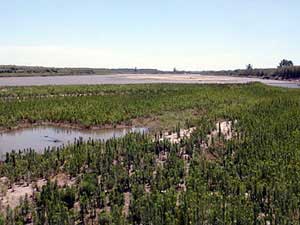|
Audio
Photos
More from MPR
Resources
|
May 30, 2005
 |
| Regulations may be tightened along the Mississippi River's National Wildlife and Fish Refuge, to further protect the habitat. (MPR file photo) |
Winona, Minn. — Don Hultman heads the Upper Mississippi River National Wildlife and Fish Refuge. He's spent his entire career working in different parts of the federal refuge system. That includes everything from years in the remote wilderness to a desk job in Washington D.C.
It wasn't long after Hultman stepped into his current position that he was handed the intimidating task of drafting a new set of regulations to keep the refuge running smoothly for decades to come. He says the result is 600 pages long.
"Congress said for all refuges there are priority public uses. They are hunting, fishing, wildlife observation, education and interpretation and photography," says Hultman. "So those six things ... have a place in the plan. And we have to address those uses, and where they are going to occur and how they are going to occur."
Hultman stands at the head of a Mississippi River boat landing, not far from Winona, in the heart of the refuge.
He says a lot of the proposed regulations are aimed at providing a more enjoyable experience for the huge numbers of visitors who flock here each year.
Some changes tackle how visitors behave, like the use of alcohol and public nudity. There are several that target motorized vehicles, like jet skis and loud motors in some of the river's pristine backwaters.
Hultman says the river has come a long way since the refuge was founded in the 1920s. He says as much as the area is a place for recreation enthusiasts, it's also home to a wide range of plant and animal life.
"When this refuge was set aside, one of its primary purposes was for waterfowl. We are a major migration corridor. We have refuges within refuges, where there's no hunting for birds. They are really stepping stones along the way for birds to rest," says Hultman. "That's certainly good for birds, but also for people who like to watch birds. And also waterfowl hunters, because birds staying here provide more hunting opportunities for people."
Hultman says so far, the most controversial part of the entire plan has to do with adding more of these hunting-free zones along the river. He says from his perspective, it's a way to increase the number of birds that flock to the Mississippi, spreading them more consistently around throughout the refuge.
Hultman says recent public meetings in Iowa and Wisconsin have been crowded with angry hunters who chafe at the thought of additional restrictions.
"When you change a closed area it sounds like common sense, and it makes sense biologically and from a public standpoint," Hultman says. "But if a duck hunter has been hunting in an area for the past 30 years and now you say, this is a closed area. 'It may improve hunting long-term, but it's still where I used to hunt.' It's very personal."
Hultman will present the new plans in Winona on Tuesday and in Wabasha on Wednesday during evening public meetings. Those who can't make it to the public hearings have until Aug. 31 to send in their comments. U.S. Fish and Wildlife officials will respond to each submission.
Hultman hopes a new set of regulations can be officially adopted in early 2006.




